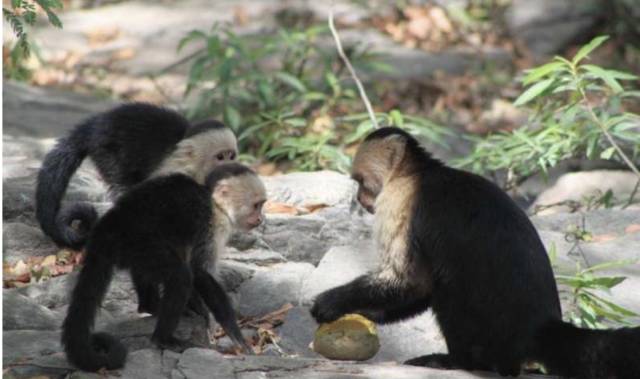对野生猴子们来说,相互学习技巧不是什么难事,但需要强调的是,社会性学习最终取决于学习能够获得的收益。r人们首次发现野生动物在学习中表现出“收益偏好”(“payoff bias”)的证据。

来源 phys.org
编译 紫苏
加州大学戴维斯分校的戴维斯分校动物研究生 Brend Barrett 在6月7日发表的 the journal Proceedings of the Royal Society B 上发表了一篇关于动物学习的文章。
“动物用来学习的心理机制是什么?”
Barrett 的研究对象是哥斯达黎加西北部的一群卷尾猴,这是加州大学洛杉矶分校教授苏珊·佩里(SusanPerry)27年的一项研究工作的一部分。卷尾猴相当有趣,因为它们具有复杂的社会行为,并且人们也已经知道这些猴子的亲缘关系和早期发育史。
“他们探索自己的世界,从中收获食物,”Barrett 说。这包括找出得到难以获得的果实和种子的新方法。猴子不同寻常的是,当他们打开水果时,他们得忍受其他猴子的围观。
有关猴子学习的可能的假说有:随大流,大部分猴子怎么做就怎么做;模仿有经验的猴子;从父母或近亲学习;从自己的经验中学习。
Barrett 和他的同事通过观察他们学会如何打开巴拿马树的果实来研究猴子的学习策略。这些大型水果中的坚果受到一种坚硬的外壳的保护,壳外有粘稠的液体,内侧带有刺激性的细毛。
Barrett说,通常情况下,一群熟悉这种水果的猴子已经有了自己打开果实的方式。这使得人们很难弄清楚猴子如何学习技术。幸运的是,研究人员找到了一群在2003年从较大群体中分离出来的猴子,并转移到没有巴拿马树的地区。一些老年动物有不同的打开水果的经验,有些没有任何经验。
高回报,快速学习
研究人员发现,大多数猴子总体采用最有效的技术来打开水果——也就是收益最高的方法。
他说:“我们发现,最有效的技术可以在短短两个星期内在一个群体那快速传播。Barrett 说,即使是已经掌握了一项开果技术的老年猴子,也可以通过观看别的猴子来获得另一种更高效的技术。
他们发现,猴子既通过观察别人,也利用个人经验学习。老年个体往往依靠自己的经验,而较年轻的猴子更加注意其他动物如何打开水果的方式。
有些猴子则坚持使用自己的技术,即使效率不高,但是他们尝试的过程依然与观察到的其他猴子的行为有关。
研究表明,通过哪种技术更有效率引导的“收益偏好”式学习在野生动物中可能比以前想象的更广泛。了解动物如何学习技能可能是重要的,例如,当考虑如何将圈养动物重新引入到野外,或将种群迁移到新的栖息地。
原文链接:http://rspb.royalsocietypublishing.org/content/284/1856/20170358
标题 Pay-off-biased social learning underlies the diffusion of novel extractive foraging traditions in a wild primate
作者 Brendan J. Barrett, Richard L. McElreath, Susan E. Perry
发表日期 Published 7 June 2017.
DOI: 10.1098/rspb.2017.0358
摘要 The type and variety of learning strategies used by individuals to acquire behaviours in the wild are poorly understood, despite the presence of behavioural traditions in diverse taxa. Social learning strategies such as conformity can be broadly adaptive, but may also retard the spread of adaptive innovations. Strategies like pay-off-biased learning, by contrast, are effective at diffusing new behaviour but may perform poorly when adaptive behaviour is common. We present a field experiment in a wild primate, Cebus capucinus, that introduced a novel food item and documented the innovation and diffusion of successful extraction techniques. We develop a multilevel, Bayesian statistical analysis that allows us to quantify individual-level evidence for different social and individual learning strategies. We find that pay-off-biased and age-biased social learning are primarily responsible for the diffusion of new techniques. We find no evidence of conformity; instead rare techniques receive slightly increased attention. We also find substantial and important variation in individual learning strategies that is patterned by age, with younger individuals being more influenced by both social information and their own individual experience. The aggregate cultural dynamics in turn depend upon the variation in learning strategies and the age structure of the wild population.
链接 https://phys.org/news/2017-06-monkey-age-efficiency.html
阅读更多
内容合作请联系
[email protected]















